Sectoral marine plan for offshore wind energy: social and economic impact assessment scoping report
Sets out the methodology and scenarios for scoping and undertaking a socio-economic impact assessment.
A.7. Commercial Fisheries
A.7.1 Sector Definition
This sector relates to the activity of catching fish and/or shellfish from wild fisheries for commercial profit ( i.e. 'catch sector' activity). This sector does not include subsistence fishing or recreational angling.
A.7.2 Overview of Activity
In 2016, the total volume of landings by UK fishing vessels (into the UK and abroad) was 701,100 tonnes with a first sale value of £936 million ( MMO, 2017). The total volume of these landings into the UK was 445,600 tonnes with a total first sale value of £689 million ( MMO, 2017).
Scotland is one of the largest sea fishing nations in Europe and in 2016 Scottish-based vessels landed 453,000 tonnes of fish and shellfish into the UK and abroad, with a value of £557 million (Scottish Government, 2017) ( Table A.7.1). This represents a 25 % increase in value in real terms compared to 2015 and a 3 % increase in the quantity landed compared to 2015. These landings constituted 65 % of the quantity, and 59 % of the value, of all landings by UK vessels into the UK and abroad ( MMO, 2017).
The pelagic species mackerel and herring are of particular importance to the Scottish fleet and in 2016, these species (together with blue whiting and horse mackerel) made up 65% by volume and 40% (£222 million) of the total value of landings made by Scottish vessels (Table A.7.1). Demersal species (including monkfish, cod and hake) made up 21% by volume and 30% by value of landings by Scottish vessels, with a total value of £169 million. Shellfish landings (including scallops, crabs and Nephrops) made up 14% by volume and 30% by value of all landings by Scottish vessels with a total value of £166 million (Scottish Government, 2017).
Table A.7.1 Landings by Scottish vessels into the UK and abroad (2016)
| Fishery Type | Landings ('000 tonnes) | Value (£ million) |
|---|---|---|
| Demersal | 95.4 | 169 |
| Pelagic | 294.4 | 222 |
| Shellfish | 63.6 | 166 |
| Total | 453.3 | 557 |
Source: Scottish Government, 2017
Figure A.7.1 shows the distribution of the value of demersal, pelagic and shellfish landings by the UK fleet, by ICES rectangle in 2016. Important areas for demersal fisheries are along the continental shelf edge and in the northern North Sea east of Orkney and Shetland. Pelagic catches are similarly distributed along the continental shelf edge and north and east of Scotland. In contrast, shellfish landings are predominantly from inshore areas, particularly around the west coast, but with some important areas also on the east coast.
Figure A.7.2 shows an overview of the spatial distribution of the value of landings from UK over 15 m vessels. There are important fishing areas in inshore areas on the west coast, along the shelf edge, around Shetland and across the North Sea. Under 15 m vessel activity tends to be concentrated in inshore areas within 12 nm and close to vessels' home ports ( Figure A.7.3).
Information sources that can be used in the assessment are listed in Table A.7.2.
Figure A.7.1 Value of demersal pelagic and shellfish landings from UK vessels by ICES rectangle, 2016
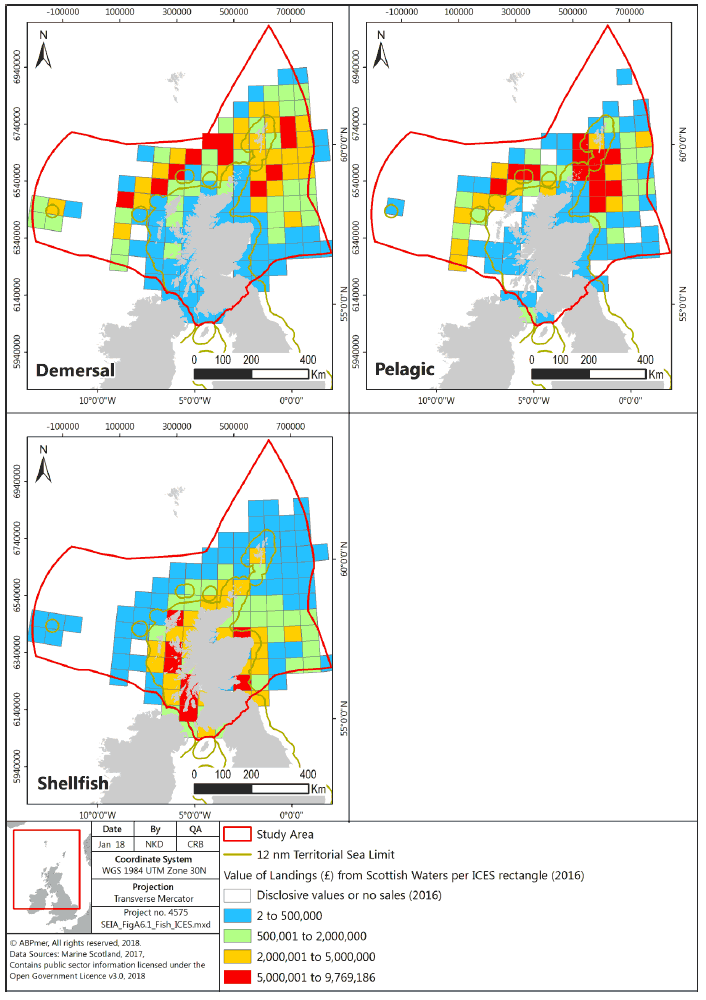
Figure A.7.2 Value of landings from >15 m UK vessels
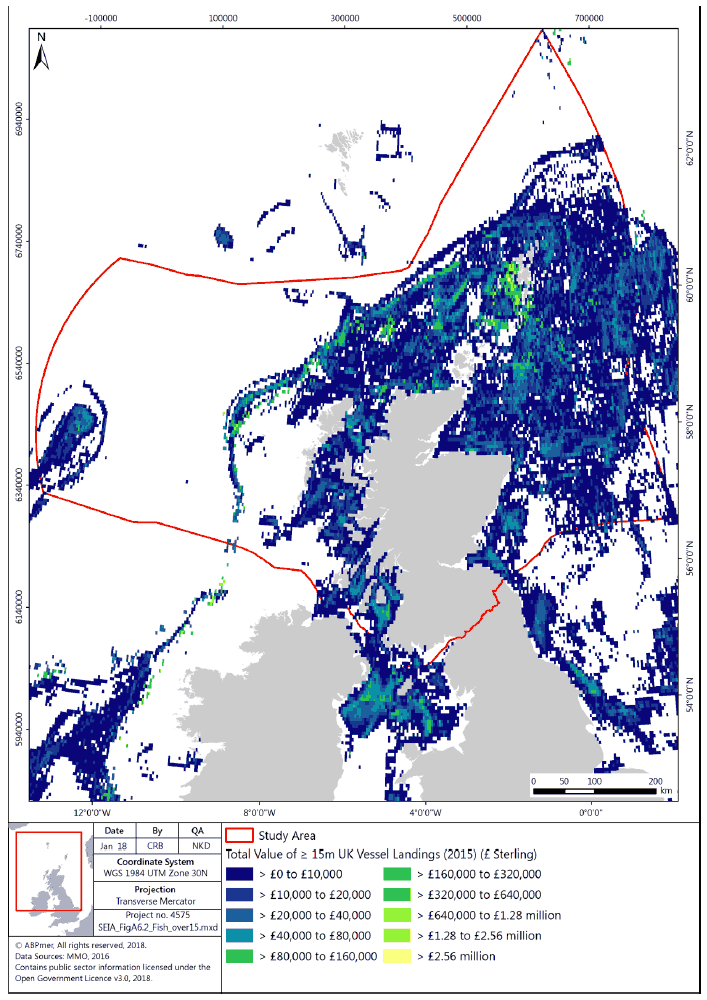
Figure A.7.3 Value of landings from <15 m vessels from ScotMap
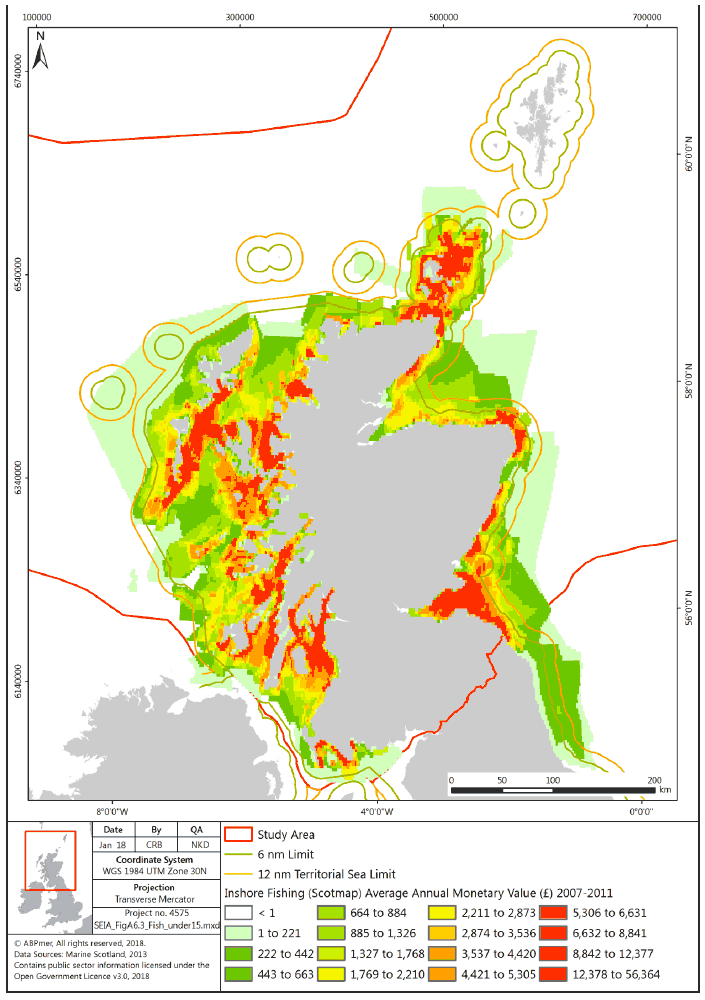
Table A.7.2 Information sources for the commercial fisheries sector
| Data Available |
Information Source (latest available data set) |
|---|---|
| Volume and value of landings ( UK/Scotland) |
By ICES rectangle ( UK/Scottish vessels): MMO 2012-2016 UK fleet landings by ICES rectangle ( https://www.gov.uk/government/statistics/uk-sea-fisheries-annual-statistics-report-2016) By Port: UK sea fisheries annual statistics (2016 data): https://www.gov.uk/government/statistics/uk-sea-fisheries-annual-statistics-report-2015 Scottish Sea Fisheries Statistics (2016 data) |
| Landings and effort of other European vessels |
Scientific, Technical and Economic Committee for Fisheries ( STECF) dataset on landings and effort by ICES rectangle for European Member States (2012-2016). |
| Spatial distribution of the value and volume of landings declaration and satellite data (for UK vessels ≥12 m in length), demersal/pelagic/shellfish |
1/200th ICES rectangle data |
| Volume and value of landings from inshore fleet |
Marine Scotland: ScotMap data (2012): http://www.gov.scot/Topics/marine/science/MSInteractive/Themes/ScotMap |
| Fleet register – number of vessels. Power and tonnage, by home port |
UK sea fisheries annual statistics (2016 data): https://www.gov.uk/government/statistics/uk-sea-fisheries-annual-statistics-report-2016 |
| Scottish salmon and sea trout fishery statistics |
Marine Scotland: Scottish salmon and sea trout catches (2016 data): http://www.gov.scot/Topics/marine/Publications/stats/SalmonSeaTroutCatches/StatPubs |
| Information on local fishery activities, operational areas and economic significance of local fisheries |
Inshore Fisheries Groups |
| Scottish Inshore Fisheries Integrated Data System ( SIFIDS) |
The SIFIDS project is seeking to develop an integrated system for the collection, collation, analysis and interrogation of data from the Scottish inshore fishing fleet. |
| OSPAR Initial Assessment data layers on surface and sub-surface swept area |
OSPAR |
A.7.3 Potential Interactions with Offshore Wind
Table A.7.3 shows potential interaction pathways between commercial fisheries and offshore wind arrays and export cables. Based on the approach to scoping described in Section 2 in the main report, the table also records whether the interaction:
- Is not likely to result in a significant socio-economic impact on the sector; or
- Is likely to result in a significant socio-economic impact on the sector and hence will require a detailed assessment.
The rationale underlying this expert judgement is provided in the table. Where it is not currently possible to make a judgement regarding the likelihood of a significant socio-economic impact due to insufficient information (for example, in relation to the extent of overlap between a sector activity and the DPO Areas) the table indicates that scoping will be required to be undertaken once sufficient information becomes available. Furthermore, as described in the main report, there is currently no information regarding the likely location of export cable routes/corridors and as such, it is not possible to undertake a meaningful assessment of the potential for any sector activity/export cable interaction to give rise to significant socio-economic effects. Rather, the potential for any interaction will be identified in Regional Locational Guidance.
Table A.7.3 Potential interaction pathways
| Potential Interaction |
Technology Aspect and Phase |
Potential Socio-economic Consequences |
Initial Scoping Assessment |
|---|---|---|---|
| Complete loss or restricted access to traditional fishing grounds |
Arrays (construction and operation) |
Reduction in landings and income, possible impact on viability of fishing businesses. Could impact on GVA of sector and employment. |
Any significant impacts would be expected where DPO areas overlap with commercial fishing grounds. The location of the DPO areas is not currently available. However, given the widespread nature of important fishing grounds in Scottish waters (for both demersal and pelagic fishing gears) and the socio-economic importance of the commercial fishing sector in Scotland, it has been assumed that avoidance of significant fishing areas may not be achieved through spatial planning alone and that the impact of this interaction will need to be assessed once the location of the DPO areas is available. Scoping assessment to be completed once DPOs defined. See Section A.7.5.1 for proposed assessment methodology. |
| Export cables (operation) |
Reduction in landings and income, increase in fishing costs (if vessels need to haul and reset gear to avoid cables), possible impact on viability of fishing businesses. Could impact on GVA of sector and employment. |
Any significant impacts would be expected where export cable corridors intersect with important commercial fishing grounds for fisheries which use mobile demersal gear. Export cable routes are uncertain. Constraints inshore of DPOs will be identified in the RLG. No detailed assessment possible. |
|
| Changes in fishing patterns, including gears used and species targeted (arising from displacement of fishing vessels as a result of loss of traditional fishing grounds; see above interaction) |
Arrays (operation) |
Change in costs and earnings profile of vessels. May lead to increased conflict over diminishing fishing grounds, and additional environmental impacts if fishing is displaced to different areas. |
Any significant impacts would be an indirect effect arising from complete loss of or restricted access to traditional fishing grounds. Scoping assessment to be completed once DPOs defined and this impact to be assessed based on the level of impact from complete loss or restricted access to traditional fishing grounds (See Section A.7.5.2 for proposed assessment methodology) |
| Export cables (operation) |
Change in costs and earnings profile of vessels. May lead to increased conflict over diminishing fishing grounds, and additional environmental impacts if fishing is displaced to different areas. |
Any significant impacts would be an indirect effect arising from displacement of vessels from traditional fishing grounds. Export cable routes are uncertain. Constraints inshore of DPOs will be identified in the RLG. No detailed assessment possible. |
|
| Obstruction of fishing vessel navigation routes |
Arrays (construction and operation) |
Increased steaming times for vessels, increased fuel cost and reduced time available for fishing for vessels with limited at-sea time ( e.g. day boats). |
The location of the DPO areas is not currently available. Fishing vessels are not included in the shipping assessment, therefore potential impacts on navigation routes should be assessed. Scoping assessment to be completed once DPOs defined. (see Section A.7.5.3 for proposed methodology). |
| Export cables (construction) |
Increased steaming times for vessels, increased fuel cost and reduced time available for fishing for vessels with limited at-sea time ( e.g. day boats). |
Export cable routes are uncertain. Constraints inshore of DPOs will be identified in the RLG. However, it can be noted that any potential impact will only occur during the construction phase (export cable laying) and hence will be temporary (see loss or restricted access to fishing grounds interaction above for impacts during operation). No detailed assessment possible. |
|
| Disruption to/obstruction of fishing activity |
Export cables (construction) |
Change in costs and earnings profile of vessels. |
Export cable routes are uncertain. Constraints inshore of DPOs will be identified in the RLG. However, it can be noted that any potential impact will only occur during the construction phase (export cable laying) and hence will be temporary. No detailed assessment possible. |
| Fouling of fishing gear on cables or seabed infrastructure |
Export cables (operation) (assumes no fishing within operational arrays) |
Loss of fishing gear, increase in gear costs, loss of fishing time and revenue. Safety issues for fishing vessels. |
Export cable routes are uncertain. Constraints inshore of DPOs will be identified in the RLG. No detailed assessment possible. |
| Disturbance of commercially-exploited fish and shellfish populations including disruption or damage to habitats, nursery and spawning grounds |
Arrays (construction) |
Reduction in Catch per Unit Effort ( CPUE), landings and income. |
Any potentially significant impacts to fish and shellfish populations would be expected to be minimised in accordance with EIA and HRA requirements and that residual impacts will not have significant impact on fishing sector. No detailed assessment required. |
| Export cables (construction) |
Reduction in Catch per Unit Effort ( CPUE), landings and income. |
Any potentially significant impacts to fish and shellfish populations would be expected to be minimised in accordance with EIA and HRA requirements and that residual impacts will not have significant impact on fishing sector. No detailed assessment required. |
|
| Array cables and export cables (operation) |
Electromagnetic effects on fish and shellfish populations resulting in changes to CPUE, landings and income |
Any potentially significant impacts to fish and shellfish populations would be expected to be minimised in accordance with EIA and HRA requirements and that residual impacts will not have significant impact on fishing sector. No detailed assessment required. |
|
| Consequential impacts to seafood processors |
Arrays (construction and operation) Export cables (construction and operation) |
Loss of profit for fish processors. |
Impacts will be a function of the loss of landings supplying the processing sector, and therefore will be a function of the impact 'complete loss or restricted access to traditional fishing grounds', taking into account any displacement effects. Scoping assessment to be completed once DPOs defined and this impact to be assessed at regional level. |
| Disruption to salmon and sea trout fisheries |
Arrays (construction and operation) |
Loss of landings. |
DPOs will not be in coastal areas where salmon and sea trout fisheries mainly occur, therefore no interaction is expected. Salmon and sea trout are protected under Habitats Regulations legislation, which requires that a HRA is conducted for individual developments. This requires that environmental impacts on salmon and sea trout are avoided. No detailed assessment required. |
| Export cables (construction) |
Loss of landings. |
Export cable routes are uncertain. Constraints inshore of DPOs will be identified in the RLG. No detailed assessment possible. |
A.7.4 Scoping Methodology
The Scoping methodology covers the following interactions (see Table A.7.3):
- Complete loss of or restricted access to traditional fishing grounds;
- Changes in fishing patterns, including gears used and species targeted;
- Obstruction of fishing vessel navigation routes;
- Consequential impacts to seafood processors.
The potential for 'changes to fishing patterns, including gears used and species targeted', is a function of the potential loss or restricted access to traditional fishing grounds. The scoping for this interaction therefore needs to take place subsequent to the assessment of 'complete loss of or restricted access to traditional fishing grounds'.
Additionally, any changes to fishing patterns will offset some of the loss of the value of landings that would occur through the loss of or restricted access to traditional fishing grounds, and therefore should be taken into account in the final assessment of the potential impact on the value of landings and change to GVA of the sector. It will also therefore influence the landings available to the processing industry, so the scoping for 'consequential impacts to seafood processors' needs to take place subsequent to the assessment of 'complete loss of or restricted access to traditional fishing grounds' and 'changes in fishing patterns, including gears used and species targeted'. The process is illustrated in Figure A.7.4.
The draft scoping outputs will be discussed with relevant industry representatives.
Figure A.7.4 Process for scoping and assessment of commercial fisheries interactions
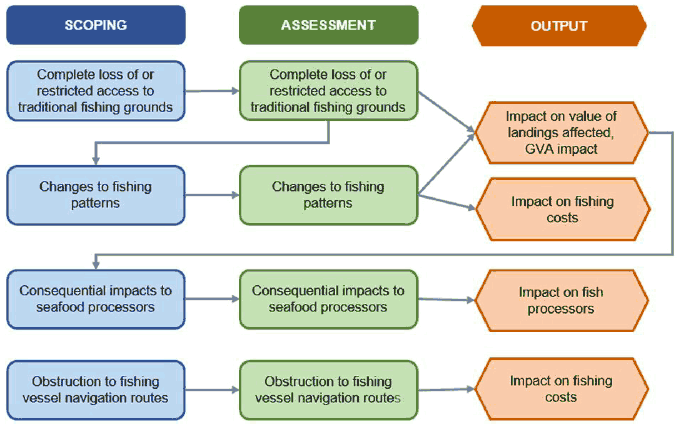
A.7.4.1 Complete loss of or restricted access to traditional fishing grounds
To determine where detailed assessments of the interaction may be required when DPO area locations are available, the following scoping criteria are proposed:
- Where DPO areas overlap with fishing grounds (see below), a detailed assessment should be undertaken. The latest five years of data should be used, taking into account both UK vessels and other nationalities where appropriate.
'Fishing grounds' should be identified based on whether there are any reported landings at the scale of ICES rectangle over the five-year period to be assessed (2012-2016).
A.7.4.2 Changes in fishing patterns, including gears used and species targeted
This interaction arises from the displacement of fishing vessels as a result of loss of traditional fishing grounds; see above interaction. To determine where detailed assessments of the interaction may be required when DPO area locations are available, the following scoping criteria are proposed:
- Where the assessment of complete loss of or restricted access to traditional fishing grounds indicates that the potential loss of the value of landings exceeds either of the following thresholds, this interaction should be assessed:
- 10% of the value of landings (for the particular fishing sector) of the ICES rectangle;
- 1% of the value of landings (for the particular fishing sector) of the region.
Regions on the west coast could follow the regions used for the socio-economic and non-monetary assessment of inshore MPA / SAC management (Marine Scotland, 2015)), see Figure A.7.5, extended further offshore as appropriate. Appropriate regions for the North and East coast should be defined along ICES rectangle boundaries in consultation with Marine Scotland and industry.
Figure A.7.5 West coast regions used in Marine Scotland (2015)
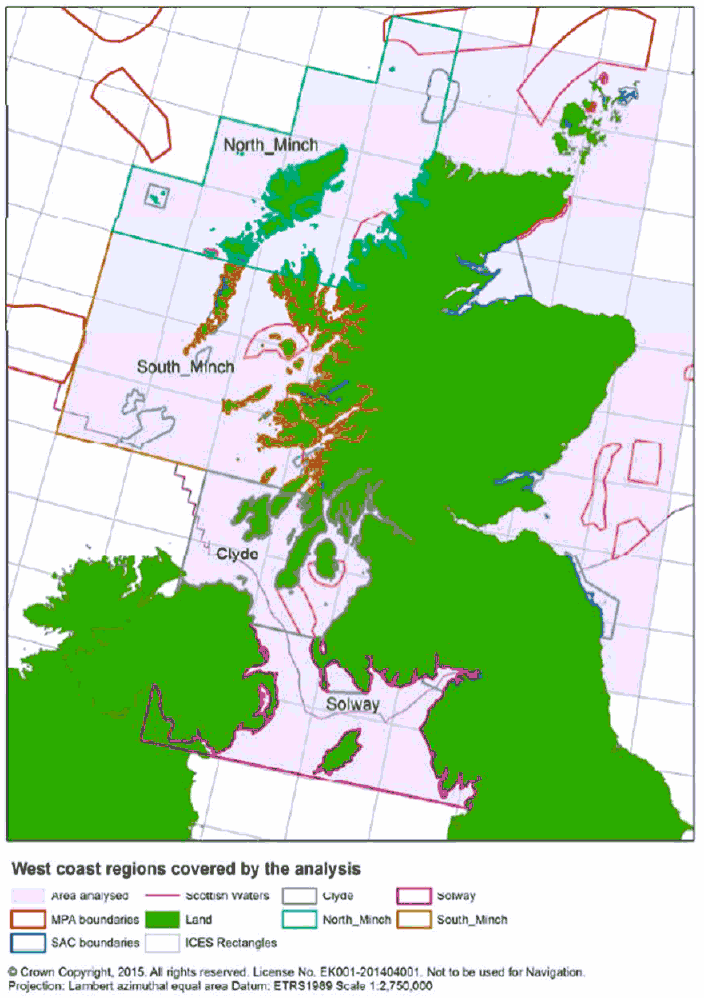
A.7.4.3 Obstruction of fishing vessel navigation routes
This interaction arises from the need for fishing vessels to alter their navigation or steaming routes from port to fishing grounds, as a result of the installation and operation of arrays. To determine when detailed assessment of the interaction will be required, the following scoping criteria are proposed:
- Where visual inspection of the location of DPO areas overlain on fishing vessels' 'steaming' pings from vessel monitoring system ( VMS) data (speed >6 knots) show that the DPO areas overlap with clear steaming routes, then a detailed assessment should be undertaken when either of the following two scoping criteria are met:
- The area to be occupied by the array exceeds 5% of the DPO area (under this threshold it is assumed that the interaction can be minimised through spatial planning; this threshold could be re-visited once the DPO areas are known);
- 'High case' development scenario (8 GW installed capacity within a DPO).
A.7.4.4 Consequential impacts to fish processors
This interaction arises from the displacement of fishing vessels as a result of loss of traditional fishing grounds; see earlier interaction. Implementation of arrays will not reduce the final demand for fish, and fish processors may offset any reduction in locally-landed supplies by acquiring a greater volume of imported fish. However, for some processing facilities that are dependent on locally-landed fish and shellfish, this may not be a viable option.
To determine where detailed assessments of the interaction may be required when DPO area locations are available, the following scoping criteria are proposed:
- Where the assessment of complete loss of or restricted access to traditional fishing grounds indicates that the cumulative loss of the value of landings ( i.e. taking into consideration all DPO areas), less the value of landings from fishing effort displaced to other areas, exceeds the following threshold, this interaction should be assessed:
- 10% of the value of landings to a region, assessed either for individual species or for species groups (demersal/pelagic/shellfish).
A.7.5 Assessment Methodology
The complete loss of or restricted access to traditional fishing grounds will result in the loss of the landings derived from that area. However, some or all of the fishing effort may be displaced spatially to other areas or to other gear types, through changes in fishing patterns, as has been demonstrated in a Nephrops fishery in the Irish Sea (Gray et al., 2016). Therefore the value of landings lost is likely to be offset to some extent by additional landings from effort that is displaced rather than lost.
The outputs of the assessment of the two interactions 'complete loss of or restricted access to traditional fishing grounds' and 'changes in fishing patters, including gears used and species targeted' therefore need to be combined to determine the value of landings affected. This is described in Section A.7.5.5.
The draft assessment outputs will be discussed with relevant industry representatives.
A.7.5.1 Complete loss of or restricted access to traditional fishing grounds
Potential negative impacts on commercial fisheries may occur principally through the loss of (or displacement from) traditional fishing grounds due to the location of arrays. The loss of fishing grounds would lead to a reduction in catches/landings and income for affected vessels. Where scoping indicates that a detailed impact assessment is required, the value of landings affected by the development and associated GVA impact can be assessed as follows:
- Average annual value of landings from the DPO area, pro-rated by the proportion of the DPO area that would be occupied by the array under the different development scenarios. This should be based on ICES rectangle data using the proportional area technique [13] . In inshore areas, the distribution of effort or value of landings from under 15 m vessels ( e.g. from ScotMap data) from within an ICES rectangle can also be used to refine or sense-check the proportional area technique. For larger vessels, VMS data can be used for the same purpose.
- Both UK and non- UK (European Union, EU) vessels should be assessed (data are not available for non- EU vessels at ICES rectangle level).
- Impact should be calculated by fleet segment and gear type, for gear types that will not be able to operate within the arrays. Impact on GVA for UK vessels should be calculated based on fleet segment-specific GVA as a percentage of fishing turnover from Seafish fleet economic performance dataset.
A.7.5.2 Changes in fishing patterns, including gears used and species targeted
(Arising from displacement of fishing vessels as a result of loss of traditional fishing grounds; see above interaction).
Where the scoping and assessment of the value of landings affected ( Section A.7.5.1) indicates that a detailed assessment of changes in fishing patterns is required, the potential scope of displacement of fishing effort to alternative areas should be assessed for each DPO area individually. This should take into consideration the activity profile of the vessels involved ( e.g. locally operating day boats vs larger-scale and more nomadic vessels) and the availability of alternative fishing grounds within the operating range of the affected vessels. This may consider the location of existing fishing grounds (from ICES rectangle, VMS and ScotMap data, amongst others) as well as suitable habitat types for fisheries with a strong linkage to particular habitats ( e.g. Nephrops and scallop). From this, a best estimate of the potential for displacement should be developed (for the central case), and a more optimistic estimate for the low case where appropriate.
The potential impacts of changes in fishing patterns should be quantified where possible, and described qualitatively elsewhere. This includes:
- Change in the costs and earning profile of vessels from additional steaming costs to reach alternative fishing grounds, changes in catch rates and target species;
- Additional displacement impacts such as increased conflict between vessels, and different gear types.
- Further information on aspects to consider in, and approaches to, the assessment of displacement is available in ABPmer (2017).
A.7.5.3 Obstruction of fishing vessel navigation routes
Where scoping indicates that a detailed impact assessment is required, the impact of the obstruction of fishing vessel navigation routes can be assessed as follows:
- the estimated potential extra steaming distance and time and average fuel and labour costs for fishing vessels.
This will be based on methods similar to those used to estimate impacts to commercial shipping (see Appendix A.13). For the high, central and low case development scenarios, the following assumptions should be used (unless scoped out):
- High case: 100% of costs as calculated above.
- Central case: 50% of costs as calculated above.
- Low case: 10% of costs as calculated above.
A.7.5.4 Consequential impacts to fish processors
Where this is scoped in for a development scenario, it can be assessed based on the difference in cost of imported vs local raw material, and the difference in price of products from imported vs local raw material, combined with the value of landings affected from UK vessels. This assumes that UK vessels land to the UK and non- UK vessels land elsewhere. It should be assessed at regional scale, based on the landings from ICES rectangles within a region [14] . For specific species where a significant proportion of landings by UK vessels are known to take place overseas ( e.g. herring, mackerel, plaice), this should be taken account of in the assessment.
A.7.5.5 Calculating the value of landings lost and GVA impact
Displacement of fishing effort will result in additional landings that may compensate for the loss of landings from the affected area, but may also result in additional costs. The assessment of the two interactions, 'complete loss of or restricted access to traditional fishing grounds' and 'changes in fishing patterns, including gears used and species targeted' therefore need to be combined to determine the impact on the value of landings and on fishing costs.
For the high, central and low case development scenarios, the following assumptions should be used:
- High case: Complete loss of the value of landings (no displacement to alternative areas).
- Central case: Loss of a proportion of the value of landings, assuming that additional landings from displacement of fishing activity to other areas compensate for part of the lost landings (see Section A.7.5.2). The proportion would be determined by an assessment of the potential scope for displacement of fishing effort (see Section A.7.5.2), taking the 'best estimate' of the potential for displacement. This should be determined for each DPO area individually.
- Low case: As for the central case, but taking a more optimistic view of the potential for displacement compared to the central case. In some cases, it may be appropriate to use the same proportions across the low and central cases.
Calculation of direct GVA impact should be based on the value of landings lost, using GVA multiplier appropriate for each fleet segment. The Seafish economic performance dataset allows GVA as a percentage of fishing income to be calculated for 30 different fleet segments.
A.7.6 Data Limitations
The publically available data under-represents fishing effort by the inshore (<15 m in length prior to 2013 and <12 m vessels since 2013), which do not have VMS, and <10 m vessels which do not have to submit logbooks. Some information is available from ScotMap, however, this data represents information relating to fishing activity for the period 2007 to 2011 (collected by interviewing fishermen with 72% vessel coverage overall), and hence may no longer be representative of current inshore fishing effort. Furthermore, the coverage of ScotMap dataset varies by region. ICES rectangle data do not provide information on port of landing, therefore in assessing the consequential impacts to fish processors it is not possible to be specific with regards landings to the UK or to specific ports. Comprehensive data on landings by ICES rectangle by non- EU vessels ( e.g. Norwegian, Faroese) are not available.
Contact
There is a problem
Thanks for your feedback